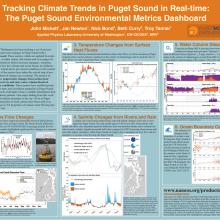Tracking Climate Trends in Puget Sound in Real-time: The Puget Sound Environmental Metrics Dashboard
John
Mickett
Applied Physics Laboratory, University of Washington
Poster
Since 2021 the Northwest Environmental Moorings Group at the Applied Physics Lab, University of Washington has been tracking a set of environmental metrics that monitor water mass changes in Puget Sound with a web-based, graphical dashboard: www.nanoos.org/products/ps_metrics. These metrics, which are updated bi-weekly and use real-time buoy and other regional observations as input, were developed to inform resource managers, scientists, health officials, and others on how key climate and ocean factors are influencing the present state of Puget Sound and to put current conditions in the context of past observations. Several of the metrics have taken the critical step of providing insight into why the observed changes are occurring. The metrics include estuarine flow changes, temperature changes from surface heat fluxes, salinity changes from rivers and rain, water column dissolved oxygen, and ocean boundary conditions. Here we present several examples of how these metrics have enabled greater understanding of recent water mass and circulation anomalies in Puget Sound, including the response to periods of drought or heavy rainfall, atmospheric heat waves, and persistent atmospheric patterns. One major finding from this work has been that temperature and salinity anomalies in the top ~60 m of Puget Sound are largely driven by anomalies in local surface heat fluxes and river flows respectively, with changes in T-S properties of water flowing into Puget Sound playing a lesser role. This project was initially funded by the Puget Sound Partnership and has been maintained with support from NANOOS.

Poster file
mickett-john-poster.pdf
(7.4 MB)
